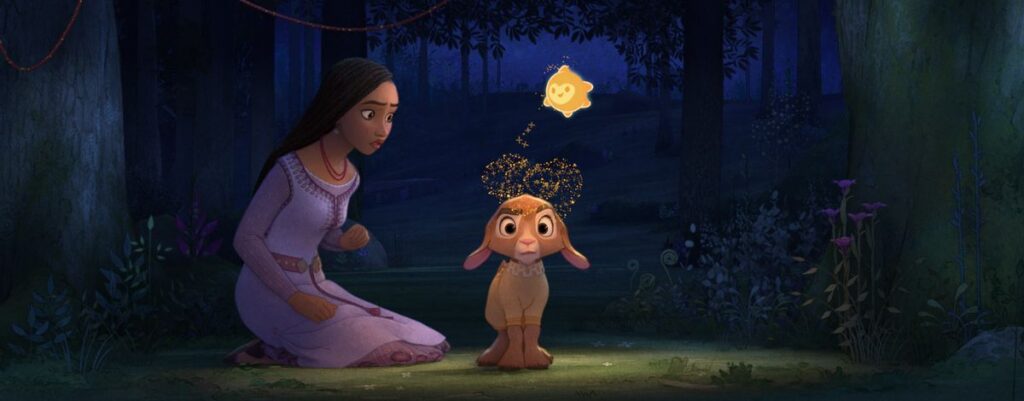Disney Animation’s new film Wish is meant as a centennial celebration of the studio’s extensive catalog. The original fairy tale follows defiant protagonist Asha (voiced by Ariana DeBose) and her little goat Valentino (voiced by Alan Tudyk) in their quest against the arrogant King Magnifico (Chris Pine), and it includes an array of visual and musical references to past Disney classics. But Valentino, who whimsically wears pajamas, is a nod to a historical note about the studio’s founder, Walt Disney himself.
“[Valentino] wears pajamas because that makes him really fun and specific, but there are also two other reasons,” Wish producer Juan Pablo Reyes Lancaster-Jones told Polygon at a pre-release junket. “One is because we’ve been researching Walt Disney’s childhood, and he would dress up his farm animals back in Marceline, Missouri. So that’s a little nod to that.”
In a general Q&A with reporters at the same event, Wish co-director Chris Buck touched on the same idea by interviewing an imagined Disney. “Where did the idea come from for you to dress up your farm animals?” Buck asked. “Because he did that, and that’s where I think a lot of the animals in clothes come from in the Disney movies.”
Image: Walt Disney Animation Studios
Valentino isn’t the only reference to Walt Disney’s childhood. As Asha sings the film’s central number, “This Wish,” which summons a living star down from the heavens, she visits the wishing tree she used to sit in with her father. “One of the things I really like — that is also a direct inspiration from Walt,” Lancaster-Jones said. “This wish sequence, we have the wishing tree that is inspired by his dreaming tree in Marceline, Missouri.”
The second reason for Valentino’s attire, Lancaster-Jones explained, is because Wish co-writer and Disney Animation chief creative officer Jennifer Lee is specifically fond of the online trend of videos featuring goats in jammies. Lee herself said the movie gave her a chance to call back to her own personal history as a storyteller as well.
“I love the stars and cosmology,” Lee said. “I love physics. I love the wonders of that, and this beauty of — what connects us all is what makes up our bones, and it comes from the center of stars.” She pointed to the lyric “We are stardust” from the Crosby, Stills, Nash & Young song “Woodstock” as an inspiration for “This Wish.”
That love of astrophysics led Lee to write a screenplay about a young physicist while she was in graduate school at Columbia University. “Brian Greene and the physicist team at Columbia read the script and gave me notes, and they work on string theory, which is in quantum physics,” Lee said. “We have Star play with yarn, really love yarn, love building things out of yarn… The theory is so hard to explain that I couldn’t even describe it, but just being able to have Star play with string was a little nod, in such a silly, silly way.”
Much like many other details in Wish, Star slowly started to become a point of reference itself as the creative team worked on it. In early iterations of the character, which Disney’s Once Upon a Studio co-director Dan Abraham participated in, Star was simplified to the point where it represented the bouncing ball, an animation lesson considered as an origin of the medium.
But the specifics of Star’s design and character are callbacks to Disney’s 100-year history, too. “We have the heart mask [around Star’s face], which is another nod to Mickey,” Buck explained. “And then Star doesn’t speak, which is another nod to the legacy of our great pantomime characters from the past.”
Wish is in theaters now.

